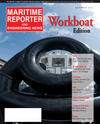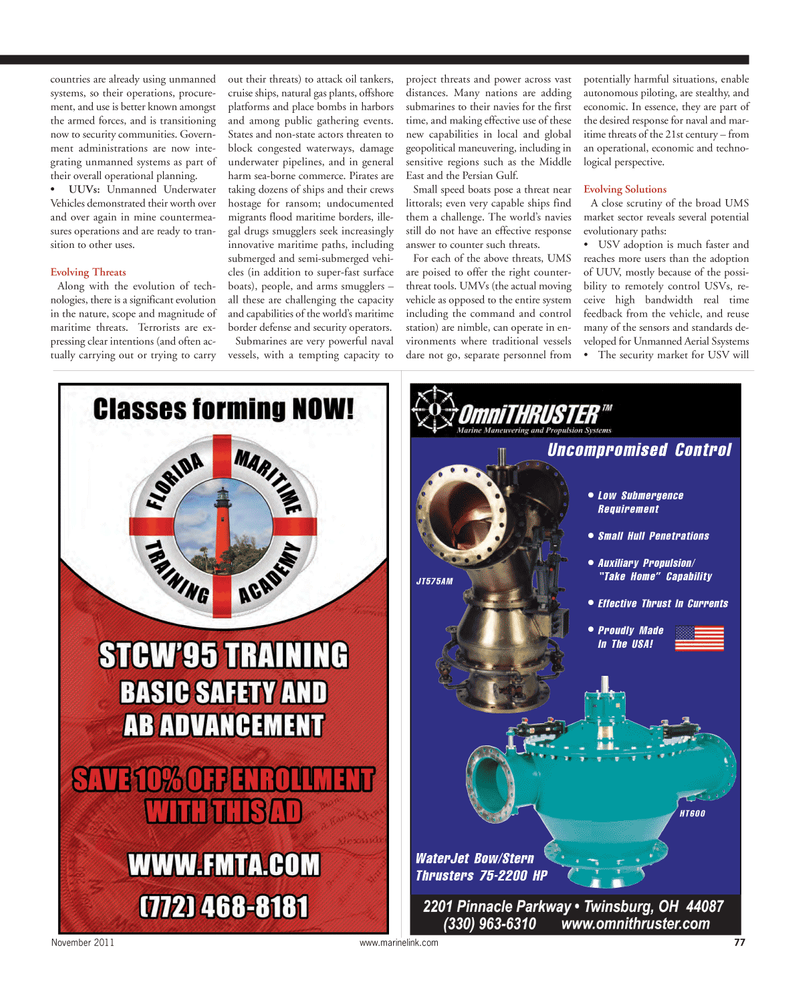
Page 77: of Maritime Reporter Magazine (November 2011)
Feature: Workboat Annual
Read this page in Pdf, Flash or Html5 edition of November 2011 Maritime Reporter Magazine
Uncompromised ControlWaterJet Bow/SternThrusters 75-2200 HPJT575AMHT600Low SubmergenceRequirementSmall Hull PenetrationsAuxiliary Propulsion/?Take Home? CapabilityEffective Thrust In CurrentsProudly MadeIn The USA!November 2011www.marinelink.com 77countries are already using unmanned systems, so their operations, procure- ment, and use is better known amongst the armed forces, and is transitioning now to security communities. Govern- ment administrations are now inte- grating unmanned systems as part of their overall operational planning. UUVs: Unmanned Underwater Vehicles demonstrated their worth over and over again in mine countermea- sures operations and are ready to tran- sition to other uses.Evolving Threats Along with the evolution of tech- nologies, there is a significant evolution in the nature, scope and magnitude of maritime threats. Terrorists are ex- pressing clear intentions (and often ac- tually carrying out or trying to carry out their threats) to attack oil tankers, cruise ships, natural gas plants, offshore platforms and place bombs in harborsand among public gathering events. States and non-state actors threaten to block congested waterways, damage underwater pipelines, and in general harm sea-borne commerce. Pirates are taking dozens of ships and their crews hostage for ransom; undocumentedmigrants flood maritime borders, ille- gal drugs smugglers seek increasingly innovative maritime paths, including submerged and semi-submerged vehi- cles (in addition to super-fast surface boats), people, and arms smugglers ?all these are challenging the capacity and capabilities of the world?s maritime border defense and security operators. Submarines are very powerful naval vessels, with a tempting capacity to project threats and power across vast distances. Many nations are adding submarines to their navies for the firsttime, and making effective use of these new capabilities in local and global geopolitical maneuvering, including in sensitive regions such as the Middle East and the Persian Gulf. Small speed boats pose a threat near littorals; even very capable ships find them a challenge. The world?s navies still do not have an effective response answer to counter such threats. For each of the above threats, UMS are poised to offer the right counter- threat tools. UMVs (the actual moving vehicle as opposed to the entire system including the command and control station) are nimble, can operate in en- vironments where traditional vessels dare not go, separate personnel from potentially harmful situations, enableautonomous piloting, are stealthy, and economic. In essence, they are part of the desired response for naval and mar- itime threats of the 21st century ? from an operational, economic and techno-logical perspective. Evolving Solutions A close scrutiny of the broad UMS market sector reveals several potential evolutionary paths: USV adoption is much faster and reaches more users than the adoption of UUV, mostly because of the possi- bility to remotely control USVs, re- ceive high bandwidth real time feedback from the vehicle, and reuse many of the sensors and standards de- veloped for Unmanned Aerial Ssystems The security market for USV will MR Nov.11 # 10 (74-80):MR Template 11/4/2011 10:21 AM Page 77

 76
76

 78
78
